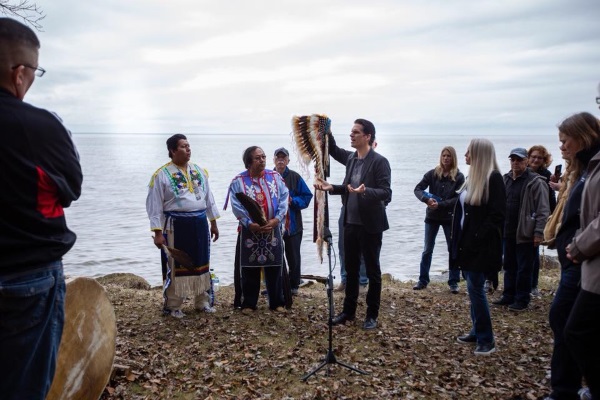
Ho-Chunks gathered at Red Banks for a reconciliation of past injustices since Jean Nicolet first landed on the shore in 1634. Since that time, waves of armies came through Ho-Chunk territory removing cultural identity and natural resources.
The ceremony was held at the Ho-Chunk Nation property near the Red Banks on May 4.
Joining the Ho-Chunk was Steven and Rene Springer, the co-founders of Global Presence Ministries from Madison.
Along with tribal members Sheridan Cloud, Pam Wilbur, and Traditional Chief Clayton Winneshiek, Springer organized the reconciliation ceremony.
Cloud met Springer at a Globel Presence Ministries event in Madison last October, where he was told of Springer’s vision.
“They were given a clear vision of a Native American Chief that was in mourn. He was standing on the banks of a lake with two soldiers on each side of him,” Cloud said. “There was a dead boy in front of him. As the chief was in mourn, the soldiers were removing his headdress.”
“The Springers perceived that the dead boy represented the gross injustice done to the Native Americans of Wisconsin along with the attempted genocide. The removal of the headdress represented the removal of identity.”
They asked if the Ho-Chunk Nation would be open to them coming to ask for forgiveness and repenting of the atrocities inflicted upon the Ho-Chunk Nation, he said.
“I said I believe the current leadership would be open to the idea. I talked with Chief Clayton Winneshiek, President Wilfrid Cleveland, and Legislators,” Cloud said.
“Identity was lost. Injustices happened. Sheridan gave us clarity,” Springer said. “Something was supposed to happen on the Red Banks.”
“The Ho-Chunk people are going to arise and erupt, and truly be the people of the sacred voice. Atmospheres in the heavens are going to change.”
Springer provided apostolic oversight to regional churches and prophetic worship and prayer. That was the reason to organize this day of reconciliation, restoration, and forgiveness.
Not only is Red Banks historically important as the site of first contact with Europeans to Ho-Chunk territory, it’s the site spoke of in the Ho-Chunk origin story. Springer was told about the origin story of the Ho-Chunk.
“The Creator actually placed the Ho-Chunk on the Red Banks,” Springer said.
Chief Winneshiek shared his thoughts on the occasion.
“We’ve lost a lot. I want the best for all the people here,” Winneshiek said.
“Thank you for having these kinds of thoughts for myself, and for the Ho-Chunk people. I say this over and over; we need to get back to who we are.”
Springer believes restoration is coming.
“We just want to reconcile and extend our apologies for the way that our ancestors, our forefathers, treated the Ho-Chunk Nation,” Springer said.
“The injustices and innocent bloodshed that took place. We just want to ask for your forgiveness.”
Springer and the other non-natives present united to say, “Will you forgive us?”
Springer explained that he is European and Ojibwa. He wanted to restore the friendship and relationship so they could move forward together as “brothers under the banner of the Creator.”
Springer shared 2 Chronicles 7:14.
“If my people, who are called by my name, will humble themselves and pray and seek my face and turn from their wicked ways, then I will hear from heaven, and I will forgive their sin and will heal their land.”
In a gesture of restoration, Springer asked non-native veterans to remove and replace Chief Winneshiek’s headdress, just as he had seen in his vision.
“We are honoring you, and replacing your identity back upon you,” Springer said.
“In this season, there are dawning days. As the sun begins to breakthrough (the clouds), because the sun is always shining, the sun of righteousness will arrive with healing on his wings, healing people’s hearts, and healing the land.”
Cloud referred to the book of Romans 8 when he addressed the people.
“God let us know that the innocent bloodshed was still crying out from the Red Banks. The forgiveness, extended by Chief Winneshiek and the Ho-Chunk people present, allows the land to receive healing,” Cloud said.
“The Red Banks is a ‘gateway’ for the waters flowing to Wisconsin. In the early days, the fur traders used Green Bay as a gateway using the waterways as a road system to go into Wisconsin and to the Mississippi. What was done there affected the rest of Wisconsin.”
Cloud asked John Morris to compose a song using the Ho-Chunk words, “Mauna managre cek karak’u kjane he,” which translates to, “The Creator is making the land new.”
Morris and his fellow singers proceeded to sing the “Chief’s song,” and then rendered the newly composed song.
Springer presented the Chief Winneshiek with a Pendleton blanket for his participation, and together they made offerings of rice, salt, oil, and water on to the ground.
Springer explained the rice represented fruitfulness.
“Fruitfulness will come to the ground again. The fruitfulness is on the land. The Creator God is healing the land,” Springer said.
The salt was to remove the bitterness, he said.
“We believe this is going to remove the bitterness of past injustices,” Springer said.
Springer said the oil represented the presence of God.
“The Almighty God, the Creator, longs to saturate the land again. It will bring healing and restoration,” Springer said.
Springer explained water represents the spirit of truth.
“It’s watering the land. The spirit of truth wants to pour out fresh and new,” Springer said.
Morris and the singers sang the “Love One Another” song as all that were present joined hand in hand during the rendering of the song.
Finally, each of the Ho-Chunks offered tobacco out onto the lake.










